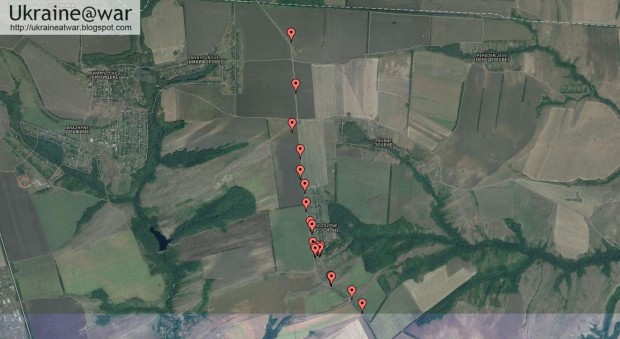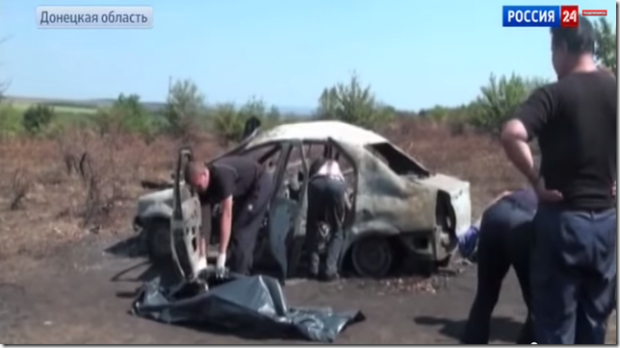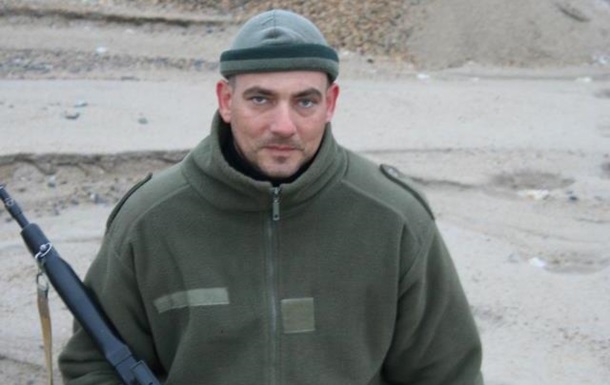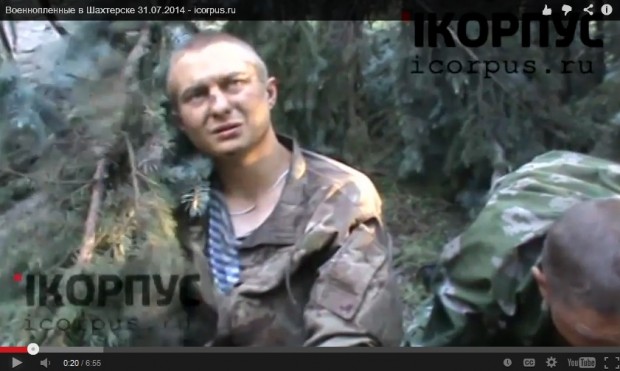When the remains of Andrei Stenin, a RIA Novosti photographer who had been missing for weeks, were finally identified and he was confirmed dead, the Kremlin’s top propagandist Dmitry Kiselyev solemnly commemorated him and angrily denounced the Ukrainian armed forces who he believed had killed him. Russian state news media gave saturation coverage to the tragedy, and Stenin was treated as a martyr for the cause of the “Russian World” and a victim of the Ukrainian government.
But there are major discrepancies in the official version of this story and a disturbing cover-up of the facts available from other sources which indicate that Stenin was tied to an extremist movement directly helping the Russian-backed separatists, and that he as well as those who told his story were involved in serious violations of journalists’ ethics.
Stenin, a Case for OSCE’s Representative on Freedom of the Media – and OSCE Monitors
For the weeks he was missing, the Russian Foreign Ministry and state media had claimed the Ukrainian Security Service (SBU) was holding him, although Kiev repeatedly denied this. Dunja Mijatovic, the Organization for Security and Cooperation in Europe (OSCE) Representative of Freedom of the Media even made an appeal for his release, denouncing the practice of abducting reporters. When ultimately DNA testing proved Stenin was dead, Mijatovic then said she was “appalled” by his “gruesome death” and called for an investigation.
No mention was made of the controversies over Stenin’s work – which involved helping both his own state media employer Rossiya Segodnya [Russia Today] as well as Russian-backed separatists make propaganda videos involving the mistreatment and humiliation of Ukrainian POWs. Nor was any mention made of the two other people traveling with him in the car, also described as “journalists” although as we shall see, they did not even characterize themselves in this way.
Mijatovic treated the case of Stenin as if he was the only person in the attack, although in fact OSCE’s Special Monitoring Mission in southeastern Ukraine had reported on the finding of several people together in one car.
In their first report, for 21 August, published 22 August , the OSCE spoke of only one body found near Snezhnoye (known in Ukrainian as Snizhne) – the town near the site of the downed Malaysian airliner:
The “deputy minister of interior” of the so-called “Donetsk People’s Republic” (“DNR”) told the SMM that the “DPR” had found a charred body on a road a few kilometres south-east of Snizhne (Snizhne is 80 km south-east of Donetsk city). He claimed that the remains were those of a missing Russian journalist, but presented no supporting evidence.
The OSCE observers then published a second report 23 August which now mentioned multiple bodies:
The SMM and representatives of the ‘Donetsk People’s Republic’ (‘DPR’) visited an area near the town of Snizhne (80km east of Donetsk) where, according to the ‘DPR’, a corpse had been discovered possibly belonging to a missing Russian journalist. The SMM saw two stationary cars in a field near the main road burned-out and damaged in a manner consistent with artillery impact. The SMM saw scattered, charred, human remains on the front and the back seats and the remains of a human skull near one of the cars. The SMM saw craters of two projectile impacts on the ground nearby, allegedly from Grad rockets. Emergency and rescue staff came to the scene and collected the charred human remains in body bags. Based on SMM’s examination of the scene, and pending forensic investigation, there is insufficient evidence to ascertain the identity of the bodies.
On 22 August, RIA Novosti published a statement from Nikolai Kryuchenko, the DPR’s deputy interior minister – the DPR official not named in the OSCE reports — who claimed, “The investigation has no evidence that this is Stenin.”
Dmitry Kiselyev, the director general of Rossiya Segodnya, the state media agency that controls RIA Novosti, RT.com and other properties, said they were still checking the story, and kept up a hashtag campaign #FreeAndrei, as if the journalist was still held somewhere.
These conflicting reports were only the first indications of strange denials and cover-up – there was much more to come in a twisted story that sheds light on the absence of ethics of Russian journalists working for the government and government media’s determination to manipulate the news for propaganda purposes, evoking more questions than answers as to why the facts have been suppressed.
Pro-Kremlin Komsomolskaya Pravda Reporters Find Three Dead
As we reported at the time, two pro-government Russian reporters, Dmitry Steshin and Aleksandr Kots of the pro-Kremlin Komsomolskaya Pravda claimed they were the ones to have found the bodies and led the OSCE team to them (although the OSCE monitor’s own report mentions DPR separatist leaders led them). In a tweet 22 August that was subsequently deleted, Steshin wrote:
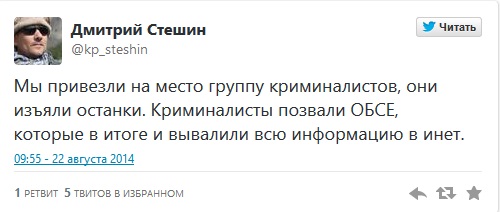 Tweet sent 22 August by Dmitry Steshin on finding Stenin’s remains, subsequently deleted.” width=”500″ height=”212″ class=”size-full wp-image-19463″ /> Tweet sent 22 August by Dmitry Steshin on finding Steshin’s remains, subsequently deleted.
Tweet sent 22 August by Dmitry Steshin on finding Stenin’s remains, subsequently deleted.” width=”500″ height=”212″ class=”size-full wp-image-19463″ /> Tweet sent 22 August by Dmitry Steshin on finding Steshin’s remains, subsequently deleted.Translation: @kp_steshin We brought a group of forensic experts to the scene, they have removed the remains. The forensic experts summoned the OSCE, which in the end put out all the information on the Internet.
Other tweets on 22 August were also deleted, but were preserved by the LiveJournal blogger hackjvc.
In his tweets dated 22 August, Steshin recounted how he went to search for Stenin with colleagues from LifeNews, a TV station with close ties to Russian intelligence, “two days ago,” i.e. 20 August and found the car 5 kilometers from Dmitrovka with burnt bodies and photographic lenses. He also described “a checkered shirt from a good Italian firm with rolled-up sleeves like Andrei liked to wear…His size…” Oddly, the shirt was intact, even though the car and bodies were incinerated.
The two reporters then published an article 22 August in Komsomolskaya Pravda which we excerpted and translated titled “How We Looked for Andrei Stenin.”
Usually when journalists disappear in southeastern Ukraine, there are some witnesses — drivers, colleagues, fighters. This time, “no one new anything at all,” said Steshin.
All that was known was that he had left together with the war correspondents of Information Corps (Icorpus.ru) of the militia, Sergei Korenchenkov and Andrei Vyachalo. He had been working with them for several weeks, the guys had made a number of reports together from the same hell. But no one had heard anything about these front reporters after their fateful departure.
The fact of Stenin’s travelling companions was then to be wiped out of the story.
By “militia,” he means the Russian-backed separatists who style themselves as a “self-defense” corps.
In trying to find his friend, Steshin began with the hypothesis that Stenin had been kidnapped by the Ukrainian army; originally Anton Gerashchenko, advisor to the Foreign Ministry, made a statement that seemed to indicate the Ukrainians could have detained him as “an accomplice in terrorism” because of his filming of the humiliation of Ukrainian POWs, but later he retracted this statement and said it was mistaken. Steshin writes:
From Moscow we ran some informal inquiries among major officials of the National Guard. We tried to find out something through SBU officers we knew who had helped us with information even during Maidan. However, no one could confirm 100% the detention of the journalists. We wrote SMSes and called on Stenin’s mobile telephone, which was working sometimes. A few times someone even answered on that line and said that the they had gotten the phone from third parties. Through the militia in Lugansk, we worked the story of an exchange for POWs of interest to the Ukrainians. But each time, the negotiations went into a blind alley — Andrei wasn’t there! Finally, we headed to the Donbass.
He was met at the Russian-Ukrainian border by LifeNews correspondents Semyon Pegov, Misha [Mikhail] Fomichev, Seryoga [Sergei] Golyandin (a correspondent who himself was detained for a time by Ukrainian forces). “The guys has already been keeping their nose to the ground in the search of their war comrade, besides their main work, for two weeks already,” Steshin wrote. This would put the date of the trip about 19-20 August; Steshin dates it on his tweet of 22 August as “two days ago,” i.e. 20 August):
“I began to find out about their possible route,” Semyon Pegov recalls today. “The situation in the border area was very difficult. I tried to find people who had seen Stenin the day that he went missing. We named various towns, finally the circle of the search narrowed to Snezhnoye. At that time I knew that for more than a week, a unit of militia men had been under siege. These were the border towns of Dmitrovka, Kozhevnya and Krasnaya Zarya. There was no communication with them, and messengers could not get through to them. This was the unit of a commander with the nick-name of ‘Poet,’ we all knew him very well from the battles near Slavyansk. I knew how Poet and his people treated journalists carefully, and even calmed down for a time. I thought they would sit it out, then they would be unblocked.
Pegov doesn’t comment on Korenchenkov and Vyachalo at all, or any efforts to track their movements and connections.
Every day, I went to Snezhnoye to get the news. Finally the situation changed on the front and one of the commanders of the militia said that the guys weren’t with him, that he hadn’t seen them. When I named the day when they went missing, his voice changed! The commander said that on that day on the road to Dmitrovka, the Ukrainian army had shot at cars with civilians. And the militia has lost a lot of fighters. In Kozhevnya, a commander with knew with the nick-name Tor also had not seen them. He had not reached there.
Parallel to this, the story with Andrei’s telephone was developing — it was turned on, and someone used it to go on his Facebook account. But if he were in captivity, they would have long ago shown him! I realized that we had to search for the car, that this was a serious hitch. Especially because the area where the guys had gone missing was known. To the extent possible, I looked through all the roads. I looked through more than a hundred strafed and burnt cars — the Renault Logan was not among them.
Steshin never inquires further about how Stenin’s mobile phone got separated from him – or any efforts to trace its location and calls and Facebook accesses which could have been done – and especially does not explain how the phone survived a shelling and wasn’t burnt up like the other items in the car.
On the way to the border, we now went together to see Poet. He said “I have found seven Logans for you. Check them out.”
Along a country road through the woods we came out near Dmitrovka. These were the abandoned positions of the Ukrainians, and the new positions of the militia. There was a memorial to a soldier Great Patriotic War [World War II], chopped in half by a shell. Under the pedestal there were wreathes covered with cement dust and flakes of silver paint. The sight was depressing — 70 years ago, they had already beaten the fascists, but evidently not all the way…We climbed up a hill and when we got on top we were horrified: the field was covered with burnt-out vehicles. Passenger cars, vans, light armor…There was the sickly smell of corpses…We passed through this sad graveyard until one of us shouted, “Stop! It’s a Logan. Like my father has.”
It turns out to be the very car that Stenin, Korenchenkov and Vyachalo were traveling in.
In the burn-out frame, the silhouette of the most common Renault can be seen. Nearby are craters from explosions of Grad rockets. But the car itself is riddled with automatic rifle and machine gun rounds. We immediately saw the human remains in the burnt-out interior. One was on the passenger seat, one in the driver’s seat and one in the rear. We found one other terrible discovery in the trunk — two professional camera lenses and the ashes of a lens which scattered from the mount…We also found the Renault logo and the Logan label.
“Clean-ups were going on in the area, the Ukrainian army was breaking out of a kettle. I think they stumbled on such a convoy which had turned down the highway and they began shooting it, [LifeNews correspondent] Semyon Pegov told them.
Clearly, the close ties of all of them to the DPR fighters facilitated the discovery of Stenin’s burn-out car and also enabled them to travel in this rebel-held territory safely.
Then, mysteriously, after it was visible for most of the day, this Komsomolskaya Pravda article was deleted without explanation from kp.ru and the sites of other papers that excerpted it. This became a sensation noted by the independent Russian press –and then oddly, the article even disappeared from Google’s cache.
Then — just as mysteriously — the article reappeared again 12 days later, now with a different headline, “How We Found Andrei Stenin,” albeit with the same text, but some different pictures, a different dateline, 3 September – and most disturbingly, a video statement from Investigative Committee spokesman Vladimir Markin telling a new version of the story unlike any previously told.
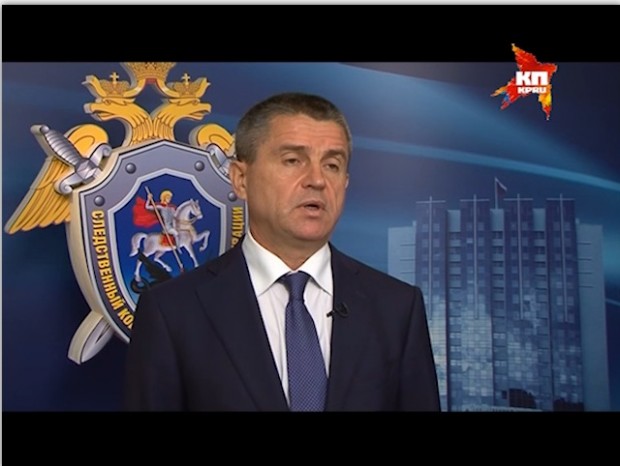 Sergei Markin, spokesman for the Russian Investigative Committee, making a statement about Andrei Stenin in September 2014.” width=”620″ height=”466″ class=”size-large wp-image-19466″ /> Sergei Markin, spokesman for the Russian Investigative Committee, making a statement about Andrei Stenin in September 2014.
Sergei Markin, spokesman for the Russian Investigative Committee, making a statement about Andrei Stenin in September 2014.” width=”620″ height=”466″ class=”size-large wp-image-19466″ /> Sergei Markin, spokesman for the Russian Investigative Committee, making a statement about Andrei Stenin in September 2014.Markin claims Stenin disappeared 6 August although the reporters had distinctly said 5 August. He has also added to the a story a claim that Stenin had been somehow travelling with a convoy of refugees fleeing Snezhnoye when the Ukrainian’s 79th air mobile brigade allegedly shot at them with high-explosive tanks shells, destroying more than 10 cars with civilians, although some managed to escape. None of this was part of Steshin’s original story or the story as rendered by Icorpus.ru, and none of it is confirmed or corroborated by any other sources. Then supposedly Ukrainian military commanders came to the scene and took the belongings of the victims. When they left, the area was supposedly strafed with Grad multiple launch rocket systems. Says Markin:
Only on 27 August did representatives of the militia transfer to Russian investigation a package with fragments of the burnt remains of human bodies in the destroyed Renault Logan on the road from Dmitrovka to Snezhnoye.
Yet Markin fails to mention that OSCE and forensic experts were involved in handling the remains on 22 August, and does not explain why it took five days to reach Moscow.
Strangely, while Markin mentioned that there were multiple “remains of persons” — admitting there was more than one person in the car – which were sent to Russian forensic experts, he then said they found that “part of them were confirmed as belonging to Stenin” without commenting on the identity of the others. There was more to come that would show his comments were out of sync with other evidence.
The “Road of Death” from Dmitrovka to Snezhnoye
According to the Russian state media and separatists’ version of events, the separatists were surrounded by the Ukrainian military, who were trying to regain control over the area of the MH17 crash site in the last week of July and first week of August, but eventually escaped. Aleksandr Ivin, a Russian fighter, writes that it was a “9-day blockade” on his video description on YouTube.
On 4 August – the day before the reporters disappeared – we reported on our Ukraine Liveblog that the OSCE said over 100 international experts have resumed work at the MH17 crash site, although earlier in the day, Ukrainian military said the investigators were blocked by separatist fighters — after negotiations they were eventually allowed through.
“The Ukrainian military says that it is not carrying out any combat activities within 20 km of the crash site and 10 km of the route of the international experts’ convoy,” UNIAN reported that day.
Grabovo (Hrabove), the town where the crash site is, is about 37 kilometers from Rassypnoye, the town near where Stenin’s burnt car was found – thus 17 km beyond the area. Yet there are no reports of fighting in this area 5 August, although there were battles elsewhere.
As we reported in our Ukraine Liveblog on 16 August (with more detail on the Russia This Week blog), some Russian soldiers, including from the Caucasus were in this very area near Snezhnoye.
As Ivin also documents, Russian forces came to the area and helped separatists “clean up” the road from Dmitrovka to Snezhnoye, which is near the crash site; Ivin labels his video in full: “12 8 2014…Moving out on a Clean-up of the Road from Dmitrovka to Snezhnoye.”
Ivin posted multiple videos of their exploits, including a video of the very Dmitrovka-Snezhnoye road of burnt-out cars Stenin and his companions had traveled. His video, labelled “2014 08 13 THIS after 9 days of the blockade of Dmitrievka a part of the road near the village of Rassypnoye” and uploaded 15 August as the meta-data indicates – has both dates well before the bodies were claimed to be discovered by the LifeNews and Komsomolskaya Pravda reporters on August 20. (Ivin, a Russian from Rostov, lets us know he isn’t a local by referring to Dmitrovka as “Dmitrievka” at first.)
It is through this video that we find one of the biggest holes in Steshin’s story.
At 1:25 in the video, Ivin says:
“For…ethical reasons, I will not show the burnt corpses that lay there for a few days which they did not allow us to take away. So we’ll show only the result of the shooting of the cars.”
That means the rebels already knew about the bodies, and had deliberately left some in place some days before 13 August.
At 3:03 on the video, where he re-starts the film, Ivin says:
There is the village of Rassypnoye. Here the main nightmares begin. There is an automobile. They were shot. Of course they already gathered up the corpses. There is the automobile. They were shot. They drove off the road. The car was burnt out. All of them were gathered up by us and taken to the morgue. How they will identify them, I don’t know, there will be specialists. Brutal, it’s all so brutal.
But…If Ivin says both that there were corpses that “they did not allow us to take away” in the first part of the video and then that “all the corpses were gathered up” in the second part, by the time he shoots a video he labels 13 August, how could Steshin later find the corpses in a car on 20 August–as if he and his comrades are the first to discover them? And which corpses were left behind?
Ivin also shows a scene of separatist fighters examining the contents of another car. So, at least a week before the Russian journalists arrived, the separatists had already taken most — but not all — of the bodies to the morgue — or so he said — and had clearly tampered with all the evidence as well.
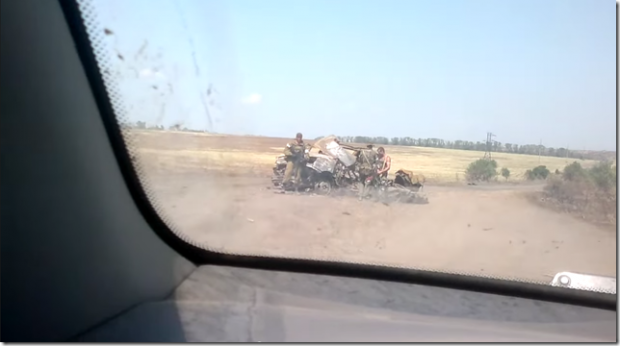
In the video at 4:43, Ivin and his fellow fighter talk about another car they’ve seen before. “Where is it? Oh, there it is,” they say, indicating that this is not their first trip along this road. “It looks like it,” says Ivin. He then says “the corpses were not found,” regarding this car and suggests they should look further in the corn field.
Ivin himself figures in a number of disturbing allegations related to the torture and murder of POWs, as does his fellow fighter, who is also recognizable in the Dmitrovka video at 8:30 due to the distinctive tattoo on his arm.
The blogger @djp3tros who writes at Ukraine@War has mapped the cars along the road, which includes the village Kashin asks about in his questions on Stenin’s death – Rassypnoye – the same village mentioned by Ivin in the video (known as Roszypnoe in Ukrainian). We asked @djp3tros to review our findings that Ivin’s video appeared to match Steshin’s story in Komsomolskaya Pravda.
At 3:32, a car can be glimpsed in the field which appears very similar to the car in the photos taken by Steshin and Kots:
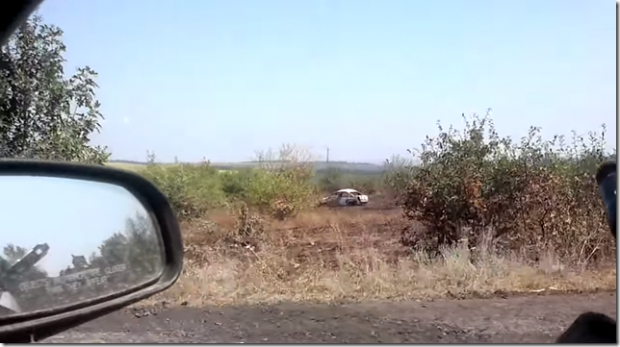
Here is the exact location of the car on Google Maps.
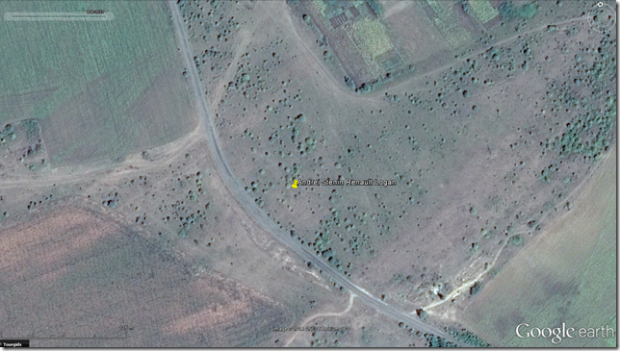 Location of the car in which the remains of Andrei Stenin, Sergei Korenchenkov and Andrei Vyachalo were found in August 2014.” width=”620″ height=”351″ class=”size-large wp-image-19512″ /> Location of the car in which the remains of Andrei Stenin, Sergei Korenchenkov and Andrei Vyachalo were found in August 2014.
Location of the car in which the remains of Andrei Stenin, Sergei Korenchenkov and Andrei Vyachalo were found in August 2014.” width=”620″ height=”351″ class=”size-large wp-image-19512″ /> Location of the car in which the remains of Andrei Stenin, Sergei Korenchenkov and Andrei Vyachalo were found in August 2014.If we compare a blow-up of the car seen in the field with the car in the Komsomolskaya Pravda original story (a photo that was removed and not included in the restored version), we see they match:
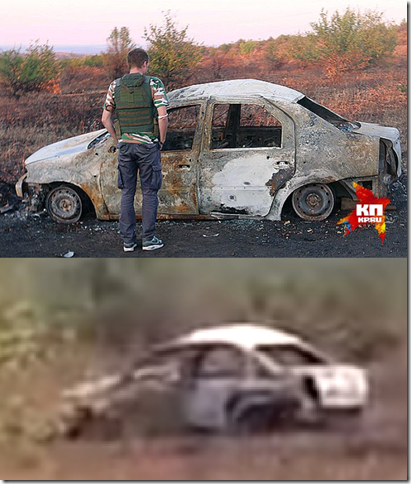
Here is what a brand-new Renault Logan would look like:

Furthermore, we can compare an antenna visible in the background in both the video and the Komsomolskaya Pravda article to show they are in the same location in Rassypnoye:
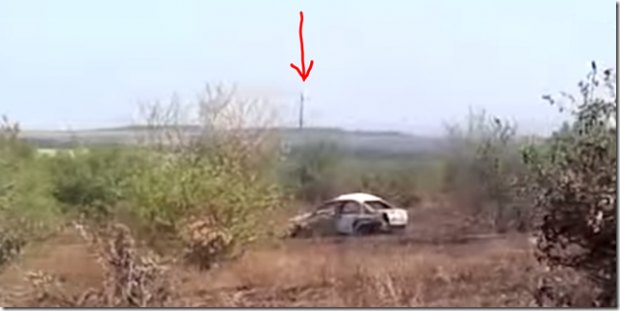
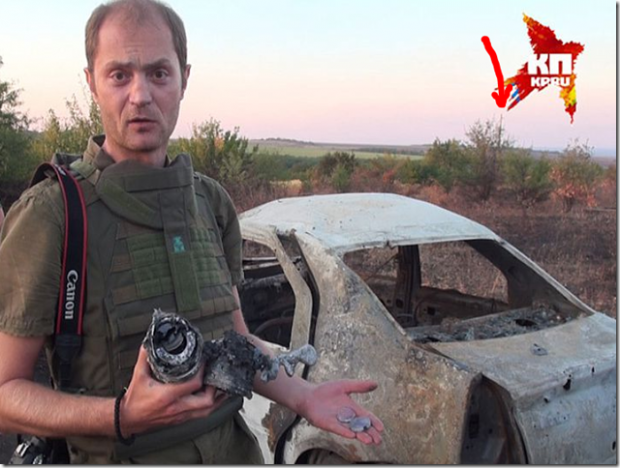
And as @djp3tros has pointed out, the scenes in Ivin’s video and Steshin’s photos also matches scenes in a video broadcast by state TV channel Rossiya 24 in conjunction with the announcement on 3 September of Steshin’s confirmed death; at 6:31, police and OSCE are seen loading the remains into a body bag:
There’s a question to be asked when comparing the views of the car over time as to whether it was tampered with or damaged deliberately. Comparing the car as seen in Steshin’s and Kots’ report and the Rossiya 24 report, we see, even allowing for shadows and a different time of day, that the body of the car has buckled and is bent in several areas:
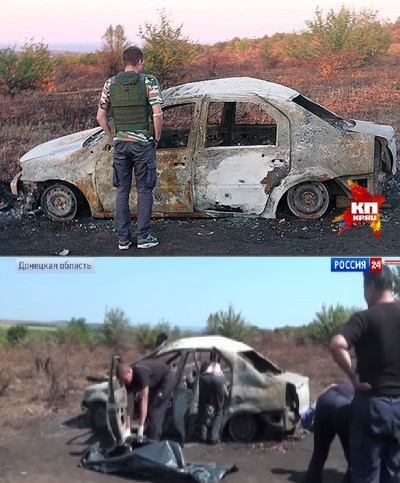
Perhaps the forensics experts themselves damaged the car further when opening the doors and removing the bodies?
Rossiya 24 claimed that the “experts” had found out “exactly” what had happened when they discovered the shelled bodies of Stenin and the others — he is the only one mentioned by the anchor, “after the car had been shelled from a tank, grenades were thrown inside the car for insurance.” Yet Stenin’s phone and a checked shirt were unharmed and the phone was still working for weeks.
Rossiya 24’s war correspondent Yevgeny Poddubny was sent to do his own investigation in Rassypnoye; no mention was made of Dmitry Steshin by now nor was there any reference to his article also claiming to discover the bodies back on 22 August–it’s as if he, too, were air-brushed out of the story by Russian state TV executives. Semyon Pegov is interviewed for this broadcast and says that for a week, from 5-6 August until about 11-12 August, there was no way to get in touch with the journalists as they were no communications — even by foot messenger — with these border towns or the separatist positions when they were surrounded.
A villager is interviewed who claims the Ukrainian soldiers shot at cars and on the scene, the reporter mentions that two other people were in the car, but does not identify them. Rossiya 24’s anchor then claims they had discovered Stenin’s phone in Slavyansk in an area controlled by Ukrainian army. The broadcast includes scenes with OSCE monitors and an interview with a local police detective who said he had confirmed from the type of holes in the vehicle that a grenade had been thrown in it and that the occupants were murdered. Then at the end, the anchor says there were refugees in the cars.
The Russian pro-government online news site Russkaya Planeta also carried an article on the OSCE statement on 22 August, then an additional report about Steshin’s find, saying , “the passengers were shot ‘from light small arms’ and the car ‘burned up from shelling of the area from missile systems’ which supposedly occurred later. Russkaya Planeta published a tweet which was also subsequently deleted that day, saying they had found the remains and called OSCE.
Although Ivin, Pegov, Steshin, and the villager all spoke of the car being “shot” as if from a gun or automatic weapon, the Donetsk detective speaks only of shelling and a grenade supposedly tossed in the interior of the car; that is another discrepancy in the various stories to investigate as it is crucial to the hypothesis that first the people inside were deliberately shot, then their murder was covered up — instead of them being caught in cross-fire.
Though Stenin didn’t want to admit it, the heavily armed rebels routinely traveled in passenger cars, as Ivin’s video of himself and other fighters in Snezhnoye indicate; arms that are only available to Russian military are shown in one of the videos, along with tanks (which may account for the reason, as we reported, why one of the videos was removed from YouTube after “copyright” complaints.) A tweet of a still from one of Ivin’s videos identifies the weapons:
BREAKING The #RUS SOF sniper unit has a spotter w mil grade radio,two 12,7 mm sniper rifles,2 secondary sniper rifles pic.twitter.com/gVRoViIdP7
— lennutrajektoor (@lennutrajektoor) August 16, 2014
And when fighters are surrounded – as they themselves reported they were in this period, they try to shoot their way out, so it cannot be said unequivocally that only the Ukrainian army did the shooting and shelling along this road. Nevertheless, that’s how “Poet” tells the story.
There are also reports from 13 August with video footage from the pro-separatist ANNA news, Novosti Rossii and Republic of Novorussia that Motorola’s brigade was operating near Snezhnoye, destroyed a division of Ukrainian soldiers and took some captive, and then on 16 August destroyed a large number of armored vehicles near Snezhnoye in an effort to prevent the Ukrainians from breaking through to the town. The separatists later showed off these destroyed Ukrainian vehicles. While the fighters were under siege for a time, they forced the National Guard to retreat. So more investigation is needed on the exact timing and sequence of the battles, along with interview of eyewitnesses.
There is another odd story that indicates the scene was accessed earlier: Oleg Kashin asks about “lenses found in the area of Donetsk, photographs of which an employee of Rossiya Segodnya named Shtol published in a group for photographers on 15 August”. That story put together with the separatists’ and Russian fighters’ video account suggest that the bodies were found earlier than claimed by Dmitry Steshin and the information somehow suppressed and the story doctored.
Dmitry Steshin, Loyal War Correspondent for the Kremlin
Why was Steshin involved in looking for Stenin, then taking part in the distorted version of the finding of his remains, then the propagandizing of his death, and the participation in a Russian criminal case charging the Ukrainian armed forces with a war crime — after the Ukrainians themselves had accused Stenin and his fellow travelers of war crimes?
To understand this, we must look at Steshin’s background, and realize he was pressed into service in this way in the past.
Steshin is a war reporter with a long history of covering wars of interest to the Kremlin within the post-Soviet space and abroad. Back in May, President Vladimir Putin, in a secret ceremony, handed some 300 journalists awards for their loyal service to the regime in the forcible annexation of the Crimea. The news of the award was leaked, and Ilya Shepelin, a journalist for slon.ru asked Kiselyev at a press briefing on 15 May on the roll-out of an anti-Maidan site ukraina.ru if he had any comment on the fact that among the awardees was Dmitry Steshin. He described Steshin as a “former editor of the neo-Nazi journal Russiy Obraz [Russian Image],” a notorious extremist publication associated with ultranationalists sentenced for murder. Kiselyev replied, “Putin has the right to give awards to whomever he wants.”
Steshin, as his entry in Russian-language Wikipedia notes, covered wars in Kosovo, Georgia (he was the only Russian journalist to get behind the Georgian lines in August 2008) and Abkhazia, the Middle East and Africa, as well as terrorist attacks such as the Beslan hostage crisis. He also covered the “color revolutions” in Kyrgyzstan, Moldova, and Mongolia.
In May 2008, Steshin pursued a statement by Carla del Ponte, the former prosecutor of the International Tribunal for the Former Yugoslavia, regarding illegal organ-trafficking by the Kosovo Liberation Army, and as a result of his stories, the prosecutor general of Serbia opened up a case based on them against the KLA which was later sent to the Hague. During the Soviet era, the KGB was notorious for planting disinformation stories with lurid claims of organ-selling in the Western media; this story conforms to this pattern.
Yet after the collapse of the USSR, the inclination was to believe various sources who claimed evidence; Human Rights Watch took up the cause. The KLA’s leaders, later government officials, are under investigation for a number of illegal detentions, abductions and killings that may well prove true, given the ample evidence. Yet a special EU Investigative Task Force found in July of this year that there wasn’t enough evidence to try specifically the organs-selling charges; a special tribunal to open next year will look further. What isn’t known is Steshin’s role in this story; it is mentioned in the Russian-language Wikipedia but not English-language accounts of this case.
Steshin appeared as a witness in the case of the murder in 2009 of liberal lawyer Stanislav Markelov and Novaya Gazeta journalist Anastasiya Baburova, because he was friends with the Nikita Tikhonov, a Russian ultra-nationalist, with whom he had gone hiking. It was Tikhonov, sentenced to life imprisonment in 2011, who brought Steshin into the journal Russkiy Obraz [Russian Image], which was associated with one of the most vicious and violent ultranationalist groups, BORN [Battle Organization of Russian Nationalists]. BORN was headed by Ilya Goryachev, a Russian ultranationalist who lived in Serbia for a time but was ultimately extradited to Russia to face trial for the murder of a number of public figures including Moscow judge Eduard Chuvash.
Mikhail Volkov, a skin-head leader of a group called OB-88 in Ukraine, was also later extradited to Russia in the BORN case. Russian journalist Andrei Trofimov has also tied a neo-Nazi activist Dmitry Mironov, a member of Russkiy Obraz, to the Sergievo-Posadsky chapter of the Mestnye movement created by the Kremlin’s “grey cardinal” Vladislav Surkov alongside Nashi as a youth movement to support Putin.
Bloggers and journalists have suspected ties between these extremists and Vyacheslav Surkov, the Kremlin “grey cardinal” who created and manipulated the government youth groups in which these activists were involved. But no one has found direct proof of his involvement.
Steshin also covered the “Arab Spring” revolutions in 2011. He, Kots and three others were even once taken hostage for a time in Libya, accused of working as intelligence agents for Qaddafi. Ultimately, due to the intercessions of Dmitry Rogozin, at that time ambassador to NATO, and Foreign Minister Sergei Lavrov, they were released. Steshin then went on to work in Syria, ultimately winding up in Ukraine in December 2013, even before the Maidan crisis. And although the Ukrainian government has now put him and his co-writer Kots on a blacklist of Russian state reporters, he continues to sneak in and report regularly from Ukraine.
Steshin and the Set-Up of a German Reporter
Steshin’s role in not only covering wars favorably for the Kremlin, but helping to prosecute Russia’s enemies, even while befriending extremists that even the government had to put on trial and accepting an award from Putin for Crimea coverage made him a figure that liberal journalists in Moscow found objectionable. But even among liberal Russian journalists and Westerners who are critical of the Russian state propagandists, there is a sense of collegiality on the battlefield. This was shattered when Steshin violated a basic code of ethics in May 2014, and admitted that he had fingered a German reporter, Paul Ronzheimer from the Berlin newspaper Bild, to be attacked by the Russian separatists, as korrespondent.net reported. Steshin was angry at Ronzheimer’s critical reporting about the separatists’ staged referendum in Slavyansk; Ronzheimer, with the help of a fixer, had discovered fraud in the the hastily-organized ballot in the “people’s republics” 11 May.
Pavel Kanygin, a correspondent for Novaya Gazeta, wrote about this incident on his Facebook page in a confrontation followed raptly by the Russian journalists’ community. The scandal even merited an article in the Columbia Journalism Review by another reporter covering the war in Ukraine, Maxim Eristravi, who explained that Ronzheimer fled the region and has not returned because of the threat to his life.
Kanygin wrote in English as well as Russian:
Just met Paul Ronzheimer from Bild zeitung who hid from Slovyansk militia. As you know they started a hunt for him after he’d tweeted some messages about how referendum was going. Now he’s ok, safe and sound. But Paul said that it was Steshin (from Moscow KP tabloid) who pointed on him and told militia to hunt the journalist and grab him.
Is that true, Dmitriy?
Steshin, who spells his name “Stechin” on Facebook, replied (translation by The Interpreter):
Yes, I wrote on Twitter about that pedo from Bild. I believe I did everything absolutely right. People have paid and are paying with blood for that referendum every day. It’s too bad they didn’t catch him.
He then added:
By the way, only that German asshole wrote about the carousels. Because there was nothing like that — people stood in lines in order to vote. They didn’t flee from beseiged Slavyansk, and they didn’t surrender.
The reference to “carousel voting” is a custom in Russia where people are bussed from one polling booth to another so they can vote multiple times, taking advantage of poor record-keeping and documentation checks or corrupt officials.
Steshin then added:
Curious, that thousands of calls to find me and Sasha Kots, and hang, shoot and tear out our guts did not cause any worry from the Bandera-loving liberal public. Strange, surely?
Pavel Kanygin then had a hair-raising reply:
“Who else did you write about, Dmitry? Your friends knocked my teeth out a few days ago, it wasn’t you who asked them to, perchance?”
Kanygin himself had been detained and tortured right before this by the separatists and fortunately released; he has done a number of the most important interviews of separatist leaders in the independent Russian press.
Stechin replied:
“You don’t know how to stage plays, Pasha, learn from the Maidan activists. You filmed your bruises at the hospital, was it painful?
Stechin then made a comment about another war correspondent, Aleksandr Babchenko, claiming he “betrayed GRU officers from Crimea” and demanding to know why he had never protested the “thousands of demands to brutally murder me and Sasha Kots” allegedly received from Ukrainians, adding , “And one tweet about a bastard journalist from Germany so chafed your butt? Do explain?”
Kanygin replied:
Dmitry, that’s enough from you, there are witnesses, and bruises, and your friends don’t deny it.
Steshin insisted on getting a scan of his injuries, and Kanygin told him to come over and see for himself. Babchenko then appeared to say, referring to Dmitry in the Russian diminutive:
“Dima, are you an idiot? Go on, tell me who I ‘betrayed’.”
This last comment – which indicated that Steshin knew GRU agents well enough to accuse another journalist of “betraying” them – added to his resume full of covering wars advantageously to the Kremlin, helping to prosecute the alleged war crimes of the KLA, winding up accused as an agent of Qaddafi, befriending an ultranationalist tried for murder, and threatening a German reporter critical of the DNR so he had to flee – was enough for some to suspect Steshin himself was working with intelligence agencies. His involvement in Ukraine in one of the chief pieces of propaganda now used by Russia against Ukraine – Stenin’s killing — could only fuel such suspicions.
Col. Strelkov’s Propaganda Helpers
While the journalists’ corps in Moscow was ringing the alarm about Stenin – as was the OSCE RoFM without mentioning he had fellow travelers — the separatist outlet Icorpus.ru did not immediately make any statement about their own people. But 5 August , a Tuesday, was already some days past when people thought the three men could have reasonably been stuck in a siege.
Then on 8 August, icorpus.ru ran an article saying that two of their “war correspondents for the information corps” were missing (translation by The Intepreter):
On 5 August 2014, Sergei Korenchenkov and Andrei Vyachalo, war correspondents for the Information Corps, disappeared. They were together in one car (a blue Renault Logan) with Andrei Stenin, a photocorrespondent from MIA Rossiya Segodnya. They were last in touch on 5 August, and reported that they were in the city of Snezhnoye and after that, communication with them was cut off.
As we reported, Icorpus.ru was proclaimed by Col. Igor Strelkov (Igor Girkin), during the period he was head of the “Donetsk People’s Republic” militia and “defense minister,” to be the news outlet that was entrusted with carrying his official direct statements, and to serve not only as reporters, but coordinators of humanitarian aid.
As Strelkov states in this video posted 18 June:
At this time, the militia has created its own information resource. The site Ikorpus has been created [screen shows http://icorpus.ru] where there will be posted, among other things, our dispatches, my own statements, reporting from Slavyansk directly and from other cities which are occupied by militia units. I also give the opportunity…the right to the staff of Ikorpus to organize cooperation with those resources which have already recommended themselves as deliverers or to be more precise gatherers of delivery of humanitarian aid, as propagandists of the militia in South East, our comrades-at-arms in the struggle against the henchmen which bomb and shell our cities every day. I hope that Information Corps will justify the trust we have placed in it, we the militia and staff headquarters and will work fruitfully for the good of the people.
To be sure, questions arose about the authenticity of Strelkov’s various outlets when a message from him was quoted on Vkontakte on 17 July about the downing of a Ukrainian AN-26 plane — which in fact turned out to be the Malaysian airliner MH17. We concluded his message was authentic because he regularly used the Vkontakte group that had taken his name as an outlet. Strelkov’s announcement blessing Icorpus was made around 18 June; the downing of the plane came 17 July, so this relatively new site had less time to establish itself than Vkontakte groups and other media that had started earlier in the war. There also appeared to be people competing with each other for the use of the name, with addresses at ikorpus.ru and icorpus.ru
In their article about their two correspondents, Icorpus.ru said they believed they were seized by Right Sector and the National Guard’s Shakhtyorsk Battalion and were at the SBU — along with Stenin (a story later dropped from official Russian claims):
Sergei and Andrei showed the real picture of what was happening in the Donbass, which was inconvenient to neither the Kiev authorities nor their American masters. Sergei Korenchenkov came to Slavyansk in the middle of May from Simferopol with one purpose: to see everything with his own eyes. After that, the desire appeared to show the whole world what in fact was happening in the Donbass. Risking his life, he repeatedly fell under artillery shells and mortar fires, under Grad fire, during tank attacks, Sergei dispassionately showed the situation from the very thick of events, from frontline positions of the war. Many times his life literally hung by a thread! But God preserved Serge from misfortunes!
Icorpus.ru appealed to all news media to help find their colleagues:
Recently you showed the subjects filmed by our war correspondents in your news shows. You got these videos absolutely free, that is, once again we emphasize that the purpose of our guys was to show the whole world the truth of this war.
But while Stenin’s case was widely publicized, while he had a hash-tag #FreeAndrei, these two provincial scribes who openly helped Strelkov’s public relations were kept out of the story, something that made their colleagues bitter, and about which they complained on various pro-separatist fora.
On 3 September, Stenin was formally declared dead when forensic analysis confirmed that the body found in the car was his, and it was confirmed that he, was on assignment near Snezhnoye (Snizhne), near the site of the downed MH17 in rebel-controlled territory when the car in which he was traveling fell under shell fire.
Ria Novosti dropped the claim that the Ukrainian Security Service (SBU) had detained him, yet Kiselyov used the occasion to blame the Ukrainian government for all the Russian journalists’ murders.
Why the Silence on Stenin’s Ultranationalist Traveling Companions?
If Stenin’s body was finally identified, why was nothing ever said about the others? Russian official media threw a veil over everything related to the circumstances of Stenin’s death. Kiselyev personally reprimanded journalists who were a few days early with the story of the identification and said time would have to be taken to finalize the investigation.
This silence prompted blogger Oleg Kashin to issue a long list of questions about the death of all three men, asking about the discrepancies in accounts, the cover-up of the relationship to the two Icorpus.ru operatives, and the involvement in an extreme movement called People’s Liberation Movement (NOD). And as we have indicated, we have even more questions given the conflicting time tables given by the fighters and journalists.
Golos Sevastopolya, a pro-Moscow and pro-Russian separatist newspaper, edited by Boris Rozhin, who also maintains the pro-separatist blog Colonel Cassad, then reported on a funeral service for one of the two Icorpus.ru workers, Sergei Korenchenkov. Evidently the identification was made much later, because the article only appeared 13 September – 10 days after the official announcement about Stenin was made.
Golos Sevastopolya said Korenchenkov’s remains had been found alongside those of Stenin and Vyachalo — although we never learn about the identification of Vyachalo’s remains. The newspaper, which supports the Russian occupation of the Crimea and the separatists, noted that they were helping to pay for the funeral expenses so that Korenchenkov could be buried in his native town of Simferopol.
The article also cites an unidentified DNR source who complained about how the life of a famous Moscow correspondent seemed more important than provincials.
Interestingly, this source said Sergei Korenchenkov was “the first person to get pictures of MH17,” that his “photos had gone all around the world,” and that he had helped others to get access to the crash site.
Korenchenkov had no training as a war correspondent, said Golos Sevastopolya, but was active in the pro-Russian movement; a video shows him shown giving a speech on the street in Sevastopol in January 2014 among people with St. George ribbons.
Another source, expert.ru, also complained about the lack of attention to Stenin’s fellow travelers:
Elena Nikitina, DNR minister of information said she didn’t know any details and had learned about the deaths from the Russian media. She also told Expert Online that they had put up condolences on the basis of information from the Russian media. Icorpus news agency, as Nikitina said was disbanded and was no longer working. Although this was exactly the main information outlet of Igor Strelkov when he headed the DNR militia.
Indeed, the site had been dormant for weeks in August after getting the imprimatur of Strelkov and running barely a month – it turned out this was not because of a lack of relationship to Strelkov, as some claimed, but the fact that its authors were long dead. While they were missing, others vied for the privilege of representing the militia. Says Expert.ru:
“It’s possible this information channel ‘died’ right when its workers died. As the DNR Defense Ministry Alina told us(she had also worked in I), both Sergei and Andre were the main people in the agency and developed it. She suggested we go to a colleague of Sergei’s and Andrei’s, Gennady Dubovoy for more information. They had worked together and he had also been together with them that day. But by a fortunate coincidence, he had not gone with them. We were unable to reach Gennady. But at the DNR they said that he and other employees of the agency really suffered over the fate of their colleagues. One of the last reports from the Information Corps which was published 8 August concerned the fate precisely of Sergei Korenchenkov and Andrei Vyachalo who were in the same car with Andrei Stenin. Their colleagues then thought that for three days they had not made contact because they were under siege.
Duma Deputy Yevgeny Fyodorov and the Popular Liberation Movement (NOD)
Looking online for materials about these two Icorpus.ru founders, we find that a prominent and powerful figure in the State Duma or parliament, Yevgeny Fyodorov who is on the council of the United Russia faction, took up their cause when they disappeared. It is this figure that Oleg Kashin also asked about.
Fyodorov is chairman of the Duma’s Committee on Economic Policy and Entrepreneurship and also involved in a number of other military-industrial commissions dealing with nanotechnology and the Eurasian Customs Union. He is also the deputy who called for rock musician Andrei Makarevich’s state prizes to be stripped from him for his opposition to the war.
Fyodorov is also founder of the Popular Liberation Movement, known by its Russian initials “NOD”, a group that has directed aided the pro-Russian fighters in the Donbass. Fyodorov makes no secret of this affiliation, which is included in his Wikipedia entry; he also mentions it in his various videotaped addresses – one of his Western fans has provided a translation of one of his prolonged rants.
A cardinal feature of his ideology is the belief that American forces have already occupied the Kremlin and that figures like Surkov, widely believed to betray the separatist cause as he maneuvers a separate peace with the Ukrainian government, is an agent of the US.
Accounts of Fyodorov in the Western press usually accentuate his wacky anti-American conspiracy theories and make him seem like a marginal figure. He is infamous for calling for the trial of Mikhail Gorbachev on the grounds that he is to blame for the break-up of the Soviet Union – an event Putin, too, describes as a “tragedy.” Fyodorov has also championed the cause to have Russia withdraw from international treaties. But Russian investigation of Fyodorov such as by Moscow journalist Aleksandr Litoy help explain how Fyodorov has used his connections and mass appeal to make trouble on Putin’s behalf, first in Crimea and then later in the southeast of Ukraine. His position in parliamentary committees related to the military-industrial complex show his close connections to army officials.
Taken individually, any of the ultranationalist groups of Vladimir Zhirinovsky or Sergei Kurginyan seem like “faux fighters,” yet collectively, all of them together supply the channels of aid and the foot soldiers of Putin’s war on Ukraine – and somewhere there are the hook-ups to the kind of supplies that can’t be bought at an army-navy store – like T72 tanks and Vintorez sniper rifles, only available to the Russian armed forces.
Fyodorov describes himself as loyal to Putin, yet advocating “different battle tactics as Litoy explains. What hasn’t been noticed about Fyodorov – likely because Moscow propagandists have worked hard to scrub the connection – is his relationship to the case of the missing Icorpus.ru workers – and their propaganda activity in collusion with the separatists.
In this video found on a NOD-supporters Vkontakte group and also uploaded to YouTube (but then just removed “due to copyright violations” — a growing problem with such videos) Fyodorov refers to the two missing Icorpus.ru reporters as “our guys.”
The narrator of the video describes Korenchenkov as active in the “liberation movement” in Crimea and Vyachalo as the “coordinator of the NOD in Donetsk,” and complains that Stenin gets all the attention as his comrades are ignored, and decides that this is because of their affiliation with NOD — which an extreme group that evidently Kiselyov doesn’t want to be associated with.
Fyodorov responds by saying “the interventionists” have taken over the Russian media, so this is “no surprise.” Fyodorov compared the treatment of the NOD operatives with the treatment by Joseph Stalin of his Communist Party comrades who were later excised from photographs. “The Americans work just this way in the Russian media,” says Fyodorov. He then draws an explicit connection between Stenin and NOD, referring to Stenin as “Andrei”:
Three people went missing who operated together. Andrei himself essentially worked in the NOD team, we of course understand that. So they can say something about him — because it is impossible to be silent about him — but about the two people, our fighters of the NOD resistance, about NOD members it is forbidden to speak in general about NOD on Russian-American television. Totally forbidden. So they must physically cut them out of reporting, out of photographs. And of course NOD must raise this, first, we don’t abandon our own, they are our NOD members, and we must raise the banner of action and to restore the truth about the abduction of Andrei, that is, to raise the issue of our activists, of Sergei and Andrei, and to fight for their release along with the journalist. To constantly confront the lying media with their own lying.
On 8 August, while other media avoided the topic of the two others in the car, interestingly, the pro-Kremlin Vzglyad ran the plea almost verbatim from icorpus.ru about their two colleagues who disappeared – Russian state media ignored it.
It was a similar pattern to that of the reporting on the initial bragging of separatists about the downing of a plane that turned out to be MH17, when both separatist outlets, Vkontakte, and Vzglyad ran similar stories.
Stenin and Icorpus.ru Both Cover Humiliation of POWs
Andrey Panasyuk, a Ukrainian soldier taken prisoner by Russian-backed militants, was among the last subjects filmed by Stenin; Panasyuk appeared in a number of photographs Stenin took while embedded with Russian-backed fighters in the “Donetsk People’s Republic” (DPR), then later he was seen in several videos made by the pro-Russian separatist news site icorpus.ru showing him being given food, water and medical treatment.
It is not known when Stenin began traveling with the two Icorpus.ru reporters, but that they were collaborating on the same story of the POWs is clear; Stenin said they had been in the same “hell” together. From the descriptions on his photos, we can see he was in Shakhtyorsk in late July during battles between separatists and the Ukrainian army. At the top of this story we can see one of Stenin’s last photos of a wounded and captured Panasyuk pleading for his life:
Here is a screenshot from one of Icorpus.ru’s videos of the same POWs:
On 2 August, a film dated 31 July was published called “POWs in Shakhtyorsk” which was also uploaded to YouTube.
The scenes leave little doubt that these are the very same POWs at the very same time and place as the ones filmed by Stenin. They were working together; not only Steshin’s account in Komsomolskaya Pravda which mentions that Stenin spent his last weeks with these men, but their photos and videos confirm that fact.
On 3 August, a film made 31 July — before the disappearances – there was another post called “A POW in Shakhtyorsk, Fellow Serviceman of the ‘Crying Paratrooper’ about Panasyuk.
On 3 August — again, before the disappearances — Icorpus.ru ran a film of Panasyuk in the hospital in Donetsk. It is said to be filed by “a war correspondent” for Icorpus.ru — and the name is not given, although it was likely the two.
On 11 August – while the reporters were “missing” – and possibly already dead – Icorpus.ru ran a film about the exchange of Panasyuk.
Here, Icorpus.ru don’t feign any journalistic distance from their subject; they are the DPR information mouthpiece (emphasis added):
On 11 August 2014, the war correspondents of Icorpus.ru, on assignment from the headquarters of the militia, traveled to the place where the POW exchange took place between the militia and the Ukrainian Armed Forces. Among the POWs was the ‘crying paratrooper’ Andrei Panasyuk who has already managed to obtain fame. During the trip, his mother repeatedly thanked the militiamen for their decent treatment of her son.
Concerns about Stenin’s violation of basic journalistic ethics, not to mention the Geneva Convention’s prohibition on taking part in the humiliation of POWs, have been expressed by the Ukrainian media. Some blogs such as Ukraine@War and The Interpreter have covered this issue, but mainstream media and international human rights organizations have not addressed it.
When the work of Col. Strelkov’s propaganda outlet is matched with Stenin, the concerns are even greater, as it seems obvious there is direct collusion between the Russian state media, which maintains at least a pretense of journalistic credibility, and the separatists’ propaganda outlets, which do not. It may have been this obvious collusion that Rossiya Segodnya and RIA Novosti wanted to cover up and keep far from the view.
Ukrainian Journalist Accuses Icorpus.ru as Accomplices of Strelkov
In an article on 13 August, Ukrainian journalist Yuriy Butusov made the point that Stenin, Korenchenkov and Vyachalo weren’t journalists, but were serving as Strelkov’s zampolity. Zampolit is a term from the Soviet era that is defined as the deputy of the commander in an army unit who took charge of political indoctrination, control and dissemination of information and morale work.
Butov goes further in charging Stenin and other Russian reporters with the kind of crimes that the International Criminal Tribunal for Rwanda tried in sentencing a radio journalist for inciting the killing of the Tsutsis.
The connections were more clear-cut and may be better documented in Rwanda than they may be for Ukraine, and there will be many organizations that will want to affirm freedom of expression even for Kremlin outlets – fearing the implications for press freedom in general — before they will want to look at the closely-intertwined activities of RIA Novosti, Icorpus.ru and Col. Strelkov. Yet that investigation must begin, because the Russian media, extremist social media, and separatist outlets all combine to create not only justification for continued aggression and incitement of mass hatred through disinformation, but the direct recruitment of fighters. As Butov notes:
The war in Ukraine goes on precisely because such groups incite hatred between people with their materials. Putin merely gives the cannon and the grenade launchers to those whom Russian propaganda has already brain-washed. They filmed our paratrooper POWs in photo and video not because someone invited Stenin for the sake of a Pulitzer prize for the rarity of the scenes in Shakhtyorsk. But because he and his “colleagues” were implementing the information resistance of the actions of the terrorist group, and were very useful to them. And they were perfectly aware of this.
Information Corps is not mass media. It’s an organ of psychological warfare, which propagandizes terrorism. And by cooperating or interacting with this publication which Girkin declared his only source of official information, the citizens of Russia Stenin, Korenchenkov and Vyachalo went out of the bounds of journalism. They turned into zampolits. BTW, Information Corps has ceased its works since the time its “authors” disappeared. And thank God.
Actually, Icorpus.ru continues to publish some dispatches from Strelkov, who is now no longer in the DNR, and various separatist leaders, but the DNR’s own web site and other pro-separatist sites now get more attention.
Butov concludes:
Stenin is an accomplice in severe crimes. The terrorists entrusted to him the photo-recording of murders of soldiers of Ukraine, representatives of the government.
More research is needed to discover exactly how this team worked together and whether and how they possibly covered POW deaths as well as the humiliation of Panasyuk, who was eventually freed and is still alive — although he and his mother — who was detained for a time by the separatists — were put through an ordeal to gain his freedom, including writing a letter to Stenin’s mother that he did not beat or torture him — to use against Ukrainian concerns that in fact Stenin had contributed to Panasyuk’s suffering as a POW.
Dead Journalists May Have Known Which Separatists Downed MH17
There’s another aspect to the story of these two pro-separatist propaganda workers helping Col. Strelkov.
On 17 July, Icorpus.ru published a claim that after the downing of the two SU-25s earlier in the week, “the enemy’s aircraft did not appear in the air again.”
This was unlike any other version of the separatist news that day.
As we reported, the accounts of Vzglyad and Russian state media made at the same time on 17 July in which separatists took credit for downing a Ukrainian AN-76 that day obviously contradict this. Clearly this version was put in later, after multiple accounts from Strelkov appeared not only in social media, but the official and pro-Kremlin Russian media indicating that the separatists thought they had shot down a Ukrainian plane at first. (We have covered the issues of Strelkov’s report of the downed plane, the authenticity of his dispatch and other evidence from Russian media which first reported the separatists’ boast of shooting down the plane. See our Evidence Review: Who Shot Down MH17? for more information.)
If Icorpus.ru ever had Strelkov’s account that appeared on the VKontakte group, they removed it so quickly no one ever noticed it.
Regrettably, the snapshot in the Wayback Machine 17 July came too late in the day to have snagged any tell-tale different account. All the accounts talk about “the fall of a Boeing,” although further research of various other blogs that may have copied or cited it might turn up something.
Although they haven’t been caught with a mistaken 17 July statement, Icorpus.ru had already proved themselves, with numerous dispatches before that, and with the film blessing them, as Strelkov’s outlet, firmly situated at the pipeline of news from the “militia.” As noted, the two were described as “first on the scene” of the MH17 and served as stringers for LifeNews and other pro-Kremlin or state media, as their colleagues stated in their plea to help find them. Perhaps they contributed some footage to this famous video which LifeNews ran and then deleted, describing a report from the “militia” that they had downed another plane – which they thought was a Ukrainian military plane, and didn’t realize was MH17 – although the amateur video used is credited to “Sergei Sidorenko” and “VK.com/Novosti Novorossii.” (There is VKontakte and at least one other Ukrainian social network where Sergei Sidorenko and Andrei Vyachalo are in each others’ friends’ list).
But if they were first on the scene, that means they had a rebel tip-off, and that means they likely knew the identity of the group of rebels who shot down the plane. They may have been the ones – not necessarily Aleksandr Boroday, then “prime minister” who handled a lot of media relations for the separatists – who called Vzglyad, ITAR-TASS and other media to help amplify the original separatists’ brag about downing a plane – after they first got the news directly from the fighters themselves – either Strelkov or one of his men.
This theoretical knowledge could also be a potential motive for their murder by anyone interested in covering up the story of MH17 – if in fact they were assassinated and not killed in crossfire. Steshin only amplified this hypothesis for their direct targeting by focusing on bullet holes in their car, which seemed to include that they were not just struck accidentally by Grad missiles, although his inference is that the Ukrainians killed them. The Ukrainian military may also have believed that these war propagandists were a legitimate target in war, yet the Ukrainian government has never taken that position, preferring to expel such propagandists from the country.
What we can see from this limited round-up of issues that shed light on the practices, affiliations and agenda of both private pro-Kremlin and state journalists in Russia is that their actions and deaths should not be treated in the same was as those with the usual Western definition of “a journalist killed on assignment,” whose death then ostensibly says something only about the level of press freedom, and the responsibilities and obligations of the government nominally in charge of the territory – in this case, Ukraine.
Instead, the scrutiny should be on Russia, which should explain why a state journalist was traveling in the car with two propagandists for the Russian-backed separatists, all of whom were members of an extremist movement tied to a Duma deputy, who scorned the norms of the Geneva Conventions to make a series of war propaganda films needed not only to oppose Ukraine and sway world opinion on the war but to recruit new fighters to Russia’s side. And the question of what and when they knew about the Russian-backed separatists’ downing of MH17 should also be probed. Ultimately, Steshin has worked with the Russian government to make a dubious claim of a war crime against the Ukrainian government – just as he did for the Serbs against the KLA – even though as we have seen his own behavior has been troubling with regard to exposing another journalist to harm, and his story about Stenin has serious discrepancies in it.
Updated 1 October with additional information on exact geolocation of the car; on comparison of the state of the cars between the photographing by Komsomolskaya Pravda and Rossiya 24‘s film broadcast 2 September; and an additional comment from Aleksandr Ivin found on the video dated 13 August of the “road of death” at 1:25 in which he notes that some of the corpses were left in place and the rest taken to the morgue, indicating they were discovered before 20 August.
